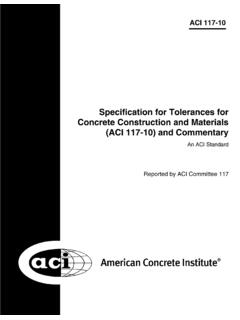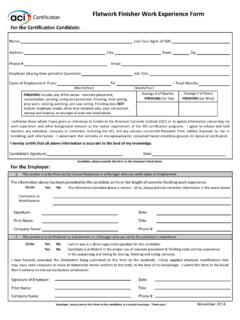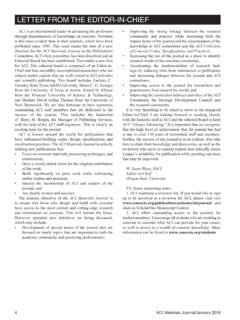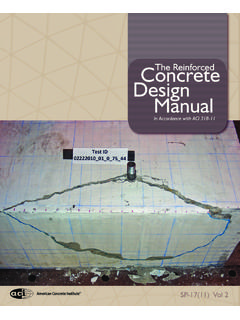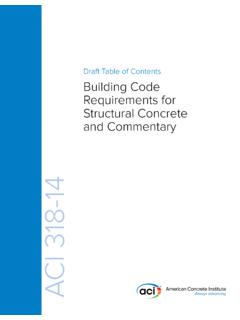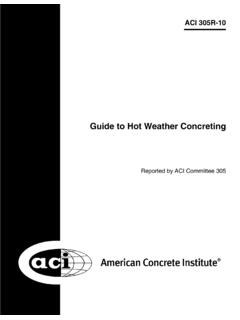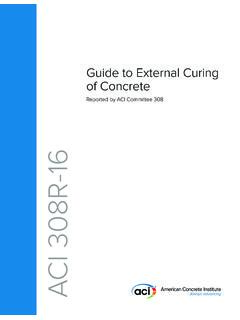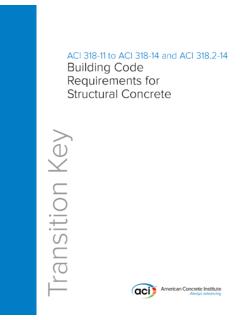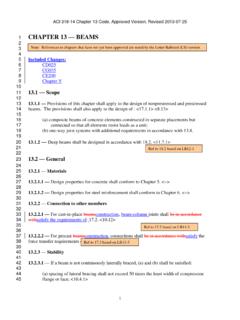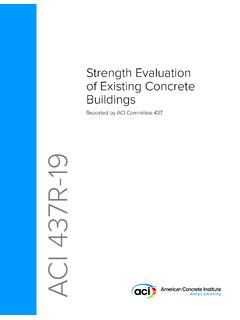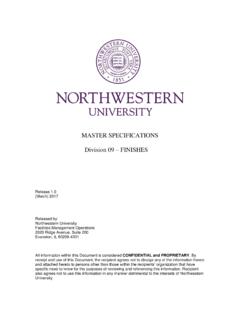Transcription of Field Guide to Concrete Repair Application Procedures
1 Field Guide to Concrete Repair Application ProceduresVertical and Overhead Spall Repair by Hand ApplicationRAP Bulletin 6watch video presentationACI RAP Bulletin 6 Field Guide to Concrete Repair Application ProceduresVertical and Overhead Spall Repair by Hand ApplicationReported by ACI Committee E706J. Christopher Ball,*ChairAhish DubeyPeter H. EmmonsTimothy R. W. GillespieH. Peter GolterFred R. GoodwinBrian F. KeaneMarc KnappKenneth M. LozenJohn S. LundDavid W. ScottAamer H. SyedGeorge I. TaylorDavid A. VanOckerDavid W. Whitmore*Primary is the responsibility of the user of this document to establish health and safety practices appro-priate to the specific circumstances involved with its use.
2 ACI does not make any representations with regard to health and safety issues and the use of this document. The user must determine the applicability of all regulatory limitations before applying the document and must comply with all applicable laws and regulations, including but not limited to, United States Occupational Safety and Health Administration (OSHA) health and safety DisclaimerThis document is intended as a voluntary Field Guide for the Owner, design professional, and Concrete Repair contractor. It is not intended to relieve the user of this Guide of responsibility for a proper condition assessment and structural evaluation of existing conditions, and for the specifi-cation of Concrete Repair methods, materials, or practices by an experienced Institute is not responsible for the statements or opinions in its publications.
3 Institute publi-cations are not able nor intended to supplant individual training, responsibility or judgment of the user, the supplier of the information Repair Application Procedure 2020, American Concrete rights reserved including rights of reproduction and use in any form or by any means, including the making of copies by any photo process, or by electronic or mechanical device, printed, written, or oral, or recording for sound or visual reproduction or for use in any knowledge retrieval system or device, unless permission in writing is obtained from the copyright proprietors. Printed in the United States of and Overhead Spall Repair by Hand Application (ACI RAP-6) 3(Reapproved 2019)4 Repair Application Procedures BulletinIntroductionOne of the most common Application methods for repairing Concrete is by hand troweling mortars to replace damaged Concrete .
4 This method can be used to Repair spalled or dete-riorated Concrete (Fig. 1) or to resurface vertical, overhead, and horizontal Concrete surfaces. Applying Repair materials by hand does not require extensive or complicated equip-ment and is ideal for shallow surface repairs, especially in areas with limited or difficult access. While both portland cement-based and resin-based Repair mortars have been used for trowel-applied vertical and overhead repairs, this Field Guide focuses on the Application of portland cement-based Repair any Concrete Repair is initiated, the root cause of the damage should be determined with a thorough condition survey of the structure.
5 Typical causes of Concrete damage can include corrosion of embedded metals from carbonation or exposure to chloride ions from deicing salts or sea spray in coastal areas; disintegration from freezing-and-thawing cycles when the Concrete is saturated with water; expansion and cracking due to alkali-aggregate reaction; or deterio-ration from chemical attack. Where possible, if the cause of damage is determined and can be prevented, necessary steps should be taken to avoid need for future Repair . Under-standing the cause of the deterioration, the owner s Repair objectives, and the in-service environment of the Concrete structure will help in the proper selection of Repair materials and Application methods.
6 To rehabilitate the overall struc-ture, Concrete Repair may need to be augmented with other technologies such as coatings or electrochemical corrosion mitigation methods (refer to International Concrete Repair Institute (ICRI) Technical Guideline ). The technique of hand troweling Repair mortars requires the selection of a sag-resistant mortar and attention to detail during Application to achieve an adequately consolidated Repair that is well-bonded to the Concrete substrate. The successful installation is a function of good surface prepara-tion, Application techniques, curing Procedures , and proper-ties of the Repair material is the purpose of this Repair ?
7 Hand-applied Repair mortars replace damaged Concrete and are generally recommended for thin repairs that are cosmetic in nature. Thin overlays of mortar can also be applied to renovate deteriorated vertical and overhead Concrete surfaces. This technique, when properly executed, improves the appearance of the deteriorated structure and provides additional protection to the Concrete do I use this method?Hand Application has been used to Repair vertical and over-head surfaces including walls, columns, beams, soffits, and building fa ades. Experienced workers using wood floats, sponges, or steel trowels can achieve a variety of finishes with trowel-applied Application of Concrete Repair materials are used to reinstate spalled or delaminated Concrete .
8 Larger and deeper repairs may be more conductive to the use Fig. 1 Spalled 2 Concrete form-and-pump, form-and-pour, or spray Application methods. Refer to the material manufacturer s recommenda-tions for recommended Repair material placement thickness. Placement thickness will vary depending on the type of materials selected and the size, depth, and orientation of the Repair cavity and may range from 1/8 to 4 in. (3 to 100 mm) on vertical surfaces, and on overhead surfaces in a single layer. Deeper placements may require the Repair material to be placed in additional layers. It is critical in applications where Repair material is applied in multiple lifts that neces-sary care is taken to ensure bond between subsequent lifts.
9 Failure to do so will result in interlayer adhesion problems and cause the Repair to do I prepare the surface?The recommended steps in properly preparing the surface to receive a hand-applied mortar are as follows:1. Concrete removal and edge conditioning Loose, delaminated Concrete should be removed until the substrate consists of sound Concrete (Fig. 2). Where corrosion of the reinforcement exists, continue Concrete removal along the reinforcing steel and adjacent areas with evidence of corrosion-induced damage that would inhibit bonding of Repair materials. Concrete removal should include Vertical and Overhead Spall Repair by Hand Application (ACI RAP-6) 5undercutting the corroded reinforcing steel by approximately 3/4 in.
10 (19 mm). The shape of the prepared cavity should be kept as simple as possible, generally square or rectangular in shape. Repair configurations with reentrant corners should be avoided to prevent stress concentration that could cause cracking of the Repair material cracking. The edges of the patches should be sawcut perpendicular to the surface to a depth of 1/2 in. (13 mm) to avoid feather edging the Repair material (Fig. 3). Avoid cutting into reinforcing steel when Final surface cleaning Use abrasive blasting where possible or other mechanical means (Fig. 4) to remove residual dust, debris, fractured Concrete , and other contam-inants that prevent proper bonding.
